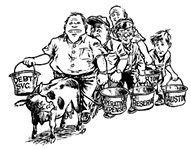The A-Word
Affordable Housing Plan Lacks Bricks and Mortar
By Kayte VanScoy, Fri., April 10, 1998
|
|
When Mayor Kirk Watson announced from the city council dais in February that the entire Austin police force would be receiving a raise, he made a short speech which hit upon the most important arguments for the pay increase. "I am hopeful that the pay raise proposal will mean our officers can afford to live in Austin and can afford to be a part of the very community they protect," he said, responding to reports that the officers' $25,000-a-year starting salary was not enough to afford housing within Austin city limits. In fact, the "Austin-police-should-live-in-Austin" argument was one ballyhooed by just about every city official and police representative that week. But nobody, strangely enough, was anxious to talk about the underlying issue that families suddenly need to earn $30,000 a year just to afford a rental house in this community. The trajectory in recent years of Austin's increasing prosperity has had the unfortunate result of changing this city from a highly affordable "slacker" town to an increasingly expensive and fast-paced environment. Affordable housing, which Watson jokingly calls "The A-word," has emerged as one of the most pressing challenges in an otherwise idyllic economy, but neither the private nor the public sector seem prepared to address the issue. A 1995 city-commissioned study by Capitol Market Research concluded that demand had already outpaced the supply of affordable housing twice over. More recently, the Greater Austin Chamber of Commerce commissioned a study which, among other findings, concluded that in the next five years affordable housing could throw a wrench into Austin's seemingly unbreakable economic machine. And yet, instead of addressing the issue head-on with its usual fervor, the council has allowed the
A-word to merely boil beneath the surface of virtually every debate - zoning, pay raises, even the proposed expansion of the convention center (see story, p.26).
Watson prefers "reasonably priced" to the
A-word, as if changing the name will solve the problem. But whatever you call it, "affordable" does have a cut-and-dried definition, at least in the eyes of the federal government. For homebuyers, houses under $67,000 are considered affordable, and for renters, $639 a month for a two-bedroom is the standard. In the 1995 study, less than 1% of new houses for sale in Austin were priced under $67,000, and the average rent ran $540 a month. Add that to the fact that jobs are being created four times faster than new housing in a market that is already 97% occupied, and you have a housing crisis on your hands.
Nevertheless, even when the council has had the opportunity make definitive decisions on affordable housing, its responses have been hopelessly muddled. In December 1997, the proposed Tannehill affordable housing complex in Northeast Austin failed on a 4-3 vote when the council caved in to the demands of nearby elderly residents. A similar 4-3 split settled the recent debate over rezoning Regency Village in Southeast Austin for mobile homes, but this time the project happened to pass when the developer wisely sweetened the pot by donating land for a school. The debate over both projects came down to bitter, "not-in-my-backyard" protests from neighborhoods who feared the influx of crime and poverty that affordable housing could bring.
If council chose to do so, it could both soothe the fears of neighborhoods and provide a plan to tackle affordable housing in a comprehensive way. Instead, councilmembers have continued to take on this most pressing economic concern on a case-by-case basis, and the results have been a patchwork of conflicting goals and projects.
The downtown initiatives, for instance, have made apparent that affordable housing is a back-burner issue for this council. First, the plan to lease out downtown land to private developers to build apartment housing downtown, and second, the expansion of the convention center, both strain credibility on council's occasional claims of concern over the housing crunch.
The ostensible benefit of building city-owned housing downtown is not as much the revenue from the leases (under $500,000 is chicken feed in an annual budget topping $5 billion) as the simple jump-start the apartments will provide for Watson's dream of a residential downtown. But, instead of deliberately lowering the benchmark for downtown rents, the council allowed the escalating real estate market to set its starting prices - $850 a month at the low end. There is nothing affordable about that, and even worse, it adds fuel to the already raging market. After some prodding, council has said it would set aside a small portion of the units at an affordable price, if you can call setting prices geared to an income of $35,000 a year affordable. Austin police officers wouldn't think so.
Railing Over Railyard
|
|
The debate over the expansion of the convention center, however, is the truly entertaining one. The way the expansion is planned, it would knock out a portion of the Railyard Apartments along Fourth Street between Trinity and Red River. The prospect has Railyard residents up in arms not only over losing their homes, but over the hypocrisy of a council patting itself on the back for encouraging residential downtown development, while simultaneously planning to destroy one of the only successful and affordable downtown apartment complexes. Angry residents have showed up at council, sent letters, and signed petitions - all to no avail.
One of the residents' favorite harping points is that the Railyard is affordable. Of course, when the Railyard Apartments - once one of the poshest addresses in town - can be touted as affordable, you know the housing market is out of control. But for the particular market niche defined by Railyard residents - predominantly yuppies - the Railyard is in fact the most affordable way to live downtown, and residents point out that none of the private or public complexes now being planned for downtown will be in their price range should they be forced to move. Renee Wardrum, a 65-year-old single woman, pays $815 a month for her two-bedroom apartment and says she values the luxury, convenience, and security of the apartments, in addition to their price. "You can't touch it anywhere else. You've got to go to the outreaches to get what I've got for the money," she says, adding that she will probably have to move far south if she is displaced by the proposed convention center expansion. Councilmembers, however, will invariably argue for the bigger picture of the Downtownland of their dreams, with huge conventions pumping up the bed tax coffers, and rich people enjoying a lakeside view. Never mind the even bigger picture that average wage-earners in Austin are being priced out of their hometown housing market.
But what can a city council actually do about an essentially market-driven problem? Quite a bit, in fact. In cities all across the country, many innovative solutions to affordable housing have been pushed through by government initiative. For example, since it is the city that approves zoning and site plans for proposed developments, it would be possible to at least attempt to steer development into lower-priced neighborhoods. Yet the Capitol Market Research study concluded that only 2% of over 16,000 housing units constructed in 1995 were built in the low-income neighborhoods targeted by the city's Neighborhood Housing and Community Development department. The study also points out that the city's own fee-assessment system hinders affordable development, since there is no reduction in fees for building affordable projects. While affordable housing developers like to turn a profit like any other business person, they are able to fill lower-cost needs by cutting down on extra expenses, and the city could help with that. The city could also promise fast-tracking for affordable housing, as it has for environmentally sensitive developers who voluntarily comply with stringent water quality codes that may not apply to their projects. Or the city could require developers of high-end subdivisions to mitigate their flooding of the market by requiring them to build affordable units as well. Even offering to broker agreements with neighborhoods surrounding affordable projects would be useful.
All of these strategies have worked in other cities. With a council that prides itself on creative problem-solving and "out-of-the-box" thinking, why couldn't the same strategies work here in Austin?
Got something to say on the subject? Send a letter to the editor.










